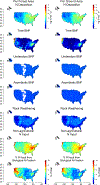A spatially explicit, empirical estimate of tree-based biological nitrogen fixation in forests of the United States
- PMID: 32665747
- PMCID: PMC7359885
- DOI: 10.1029/2019GB006241
A spatially explicit, empirical estimate of tree-based biological nitrogen fixation in forests of the United States
Abstract
Quantifying human impacts on the N cycle and investigating natural ecosystem N cycling depend on the magnitude of inputs from natural biological nitrogen fixation (BNF). Here, we present two bottom-up approaches to quantify tree-based symbiotic BNF based on forest inventory data across the coterminous US plus SE Alaska. For all major N-fixing tree genera, we quantify BNF inputs using (1) ecosystem N accretion rates (kg N ha-1 yr-1) scaled with spatial data on tree abundance and (2) percent of N derived from fixation (%Ndfa) scaled with tree N demand (from tree growth rates and stoichiometry). We estimate that trees fix 0.30-0.88 Tg N yr-1 across the study area (1.4-3.4 kg N ha-1 yr-1). Tree-based N fixation displays distinct spatial variation that is dominated by two genera, Robinia (64% of tree-associated BNF) and Alnus (24%). The third most important genus, Prosopis, accounted for 5%. Compared to published estimates of other N fluxes, tree-associated BNF accounted for 0.59 Tg N yr-1, similar to asymbiotic (0.37 Tg N yr-1) and understory symbiotic BNF (0.48 Tg N yr-1), while N deposition contributed 1.68 Tg N yr-1 and rock weathering 0.37 Tg N yr-1. Overall, our results reveal previously uncharacterized spatial patterns in tree BNF that can inform large-scale N assessments and serve as a model for improving tree-based BNF estimates worldwide. This updated, lower BNF estimate indicates a greater ratio of anthropogenic to natural N inputs, suggesting an even greater human impact on the N cycle.
Figures






References
-
- Abrahamson I. (2019). Fire Effects Informatoin System (FEIS). Retrieved from https://www.feis-crs.org/feis/
-
- Ackerly D. (2004). Functional strategies of chaparral shrubs in relation to seasonal water deficit and disturbance. Ecological Monographs, 74(1), 25–44.
-
- Antoine E. (2004). An ecophysiological approach to quantifying nitrogen fixation by Lobaria oregana. The Bryologist, 107(1), 82–87.
-
- Azani N, Babineau M, Bailye CD, Banks H, Barbosa A, Pinto RB, et al. (2017). A new subfamily classification of the Leguminosae based on a taxonomically comprehensive phylogeny – The Legume Phylogeny Working Group (LPWG). Taxon, 66(2016), 44–77. 10.12705/661.3 - DOI
Grants and funding
LinkOut - more resources
Full Text Sources
Research Materials
Miscellaneous
